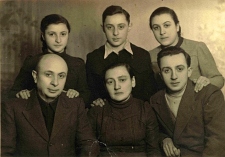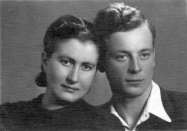|
Document of Voyev. Historical Commission in Bialystok
June 27, 1945
L.B. -- 30
Reported by Menachem
Finkielsztejn, born in 1923.
Lived in Radzilow until the liquidation of the Jews.
For 43 months he hid out at the homes of various Poles in the vicinity.
Attested to by L. Rottstein.
After the entry of the Red Army in the Grajewo vicinity in 1939, a wave of sabotage began
against the Soviet Regime. Very often murders of Soviet officers and officials of the
Soviet Regime took place. After long investigations it was discovered who were the
perpetrators. In 1940, there was a strong band of armed partisans in the woods of the
village Bilineh near Radzilow. After a battle, which lasted several days, the perpetrators
were driven out and many were shot. From those who were arrested it became evident that
the band of partisans was composed especially of local inhabitants who had run away
because of earlier actions. The large number of arrests did not however liquidate the
partisan bands completely. The acts of sabotage and murders recurred.
|
|
|
|

|
|
Finkielsztejn Family
Upon arrival in Israel, 1946
[Bottom row L-R]: Yisrael Finkielsztejn, wife Chaya (nee Wasersztejn)
Finkielsztejn and eldest son Menachem
[Top row L-R]: Chana, Sholem, Yaffa
Entire family of six survived the Holocaust
Went to Israel, 1946 |
|
| |
|
In the summer of 1941, the Commander of the NKVD [The
Committee for State Security: the Soviet counterpart of the Gestapo, and the forerunner of
the KGB] in Jedwabne was murdered in the woods near the village of Glinki. Through the
Germans it became known that those who carried out this murder were the brothers
Byenkowski from the village of Romany, Przytuler [Przytuly] community.
The regime escalated to a new extermination of the secret
organization, but just then the war between Germany and the Soviet Union erupted. The
arrested criminals were let out of prison, and the rest, who had been in hiding, came out
and began officially working with the Germans. Subsequently it was discovered who had been
the perpetrators of the acts of sabotage and murders of the Soviet Regime. It was also
discovered that a secret organization had been working under the name of "A.K."
[Armia Krajowa, or Home Army], which had had contact with the Germans throughout the
period of the Soviet occupation. They stepped forward to aid the Germans from the moment
of their invasion.
On the 23rd of June, 1941, Alexander Layewski, resident of
the village Loje Awissa, together with Tadeyush Pyatrawskin from Radzilow and several
others, moved forward with arms against the retreating Red Army which had fought against
Loje Awissa through the River Biebrza. They disarmed the Red Army, took their arms, and
beat them hard. That same day a triumph gate was set up in Radzilow on the Lomze highway
to welcome the German army. Hitler's portrait was hung up along with the slogan:
"Long live the German army that has freed us from the accursed Jewish-commune."
With the entry of the first German tanks many Polish
civilians stepped forward to their aid. Thus, for example, through the help of Widenetzi
Pyatrowski together with Myetshislow Shtcheletzki, and his brothers from
Radzilow, 18 Red
Army soldiers who had been hiding in the rye fields were discovered. Boleslaw Gawetzki
discovered 7 Red Army soldiers in the cemetery and turned them over to the Germans and
through them they were shot.
On the 24th of June, 1941, a group of Poles with whom I was
acquainted - Antoni Kosmaczewski, Jozef Kosmaczewski, Feliks Mordasiewicz from Radzilow -
received arms and drove their first tanks through the River Biebrza in the direction of
Trzcianne, in order to circle the Osowiec fortress. After taking Osowiec on the 23rd of
June, the German officers distributed to selected German soldiers orders, money, rewards,
and written thanks to the above mentioned persons.
|
|
|
|
 |
|
Frume Dorogoj and Shlomo Klein
[Photo taken in Lodz, 1946]
Frume escaped just as the Germans advanced into town and she made her way to Latvia, then deep into Russia (married Shlomo),
and eventually to Israel in 1948;
Returned to Lodz in 1946 to sell his family's property for a meager sum; Was afraid to return to Radzilow; Mistakenly identified in the Grajewo YB
as the first person killed in Radzilow, when it was actually her sister Szyma |
|
|
| |
|
On the 26th, the German regime distributed arms to trusted
people, in order to get even with the Bolsheviks and the Jews. The first act was the
murder of the Communist Youth member Frume Dorogoj, age 17 [Actually, it was Frume's
sister who was murdered (according to Anna Bikont, who interviewed elderly
Radzilow residents for her upcoming book, she was told her name was Szyma
Dorogoj, one of the "most beautiful girls in town"); Frume escaped just as the Germans
advanced into town and she made her way to Latvia, then deep into Russia, and eventually to
Israel in 1948; She met and married Shlomo Klein in Russia; After the war, they
returned to Poland, to his birthplace of Lodz, to sell his family's property for
a meager sum; She wanted to return to Radzilow and do the same but was afraid to
because of "bandits" in the road who would attack and rob for money; She was aware of the error in the Grajewo Yizkor Book]. The perpetrators
were Skrandzki, a tailor and Anton Kosmaczewski from Radzilow. Declaring that it is a pity
[to waste] a bullet in this fashion, they decapitated her in front of Kolonyeh Kopanskes
and threw her body by the feet into the Bagneh.
On July 7, 1941, at three o'clock in the afternoon,
the Gestapo went together from Stawiski to Radzilow. At their command, trusted individuals
were called who were already prepared to get even with the Jews. At the market place they
called together, 1700 Jews, men, women, children and elderly. The "gangsters"
encircled the market so that no one could escape. Walking about among those who were
forced together were Yanek Walszewski, the so-called "American," Yanek
Mordaszewski and Feliks his brother, Henryk Dziekonski and his brother Yan, and many
Gestapo members. They beat the Jews bloody. Thus, for example, they beat the old shoemaker
Artel Lipinski. He was covered with blood, unconscious. They hung a heavy stone around the
neck of the former policeman T. Shtshani. As he fell under the heavy burden, the murderers
beat him mercilessly. Many others fell in this manner. Then they all began to sing
"Moscow Moyah" and they went about beating everyone, including small children
and old people.
After accomplishing these cruel deeds, the Gestapo members
exclaimed: "We give you three days to reckon with the Jews." They distributed
arms to the "gangsters" and left. The execution started: the
"gangsters" armed with machine-guns and revolvers drove those assembled into
Mitkowski's barn, which is located near the village Radivyesh. They purposefully
jammed the doors, drenched the barn with kerosene, and ignited it. When the barn was
already in flames, they brought the captured Jews and forced them up a ladder to the roof
and then inside. They cut with bayonets those who did not carry out the command, and threw
them into the fire. A few who succeeded to crawl out from the fire were shot by the
murderers who encircled the barn. The singing and loud cries of the thugs accompanied the
horrible laments and awful cries of the unfortunates who met their deaths in the fire. The
spilling of blood was not enough for these creatures. They had a slogan: "Kill to the
last one." They started to search out Jews in the entire area. In the course of three
days, they found another few hundred Jews. They killed them in a bestial fashion. Many
they forced into the barn, drenched them with benzene and burned them alive. A great many
they shot near the barn, beating them murderously before death. Because of a lack of
ammunition, they allowed the heads of small children to be cracked with fists or pounded
with fists until they were dead. They tore some limbs from living souls, and beat up
victims before carrying out the murders. After the fire, they entered the barn and tore
gold teeth from the dead bodies.
The pogrom lasted three days, from the 7th to the 10th of
July, 1941. On the third day, some Germans came and yanked away several victims from the
hands of the thugs, exclaiming that they had already permitted too much [violence]. One
can imagine the sight of these horrible deeds, if the Germans themselves interceded.
Those who carried out the above-mentioned murders were:
Jozef, Antoni and Leon (brothers) Kosmaczewski, Ludwig Kosmaczewski, later a policeman,
Leon Paszkowski, Aleksander Gorlewski and his brother Felek, who came from Turmeh on June
2, 1941, Laschewicz, a German policeman, Henryk Dziekonski and his brother Yan.
Witness -
Protocolant -
Chairman of the Jewish Voyev. Historical Commission
|